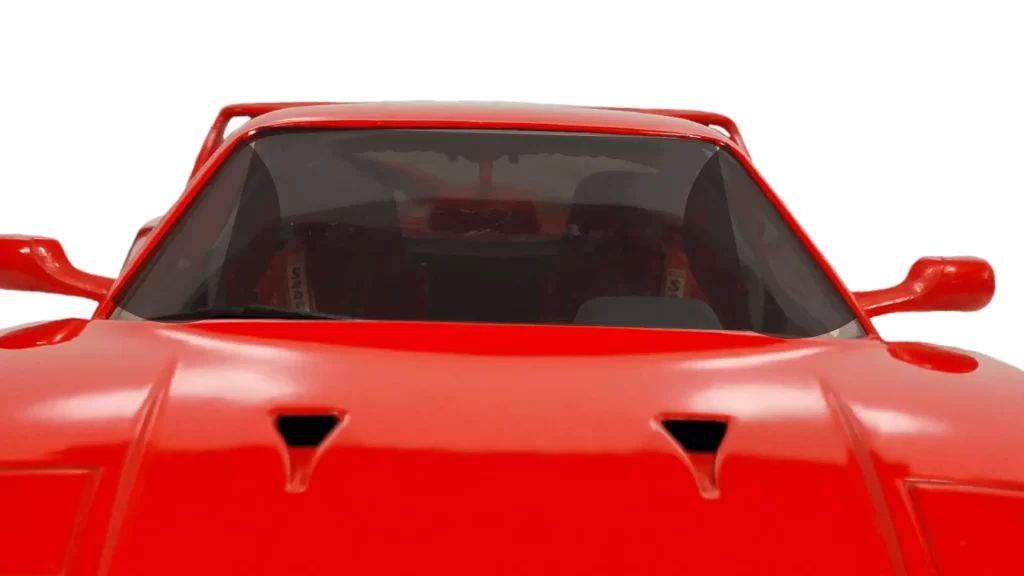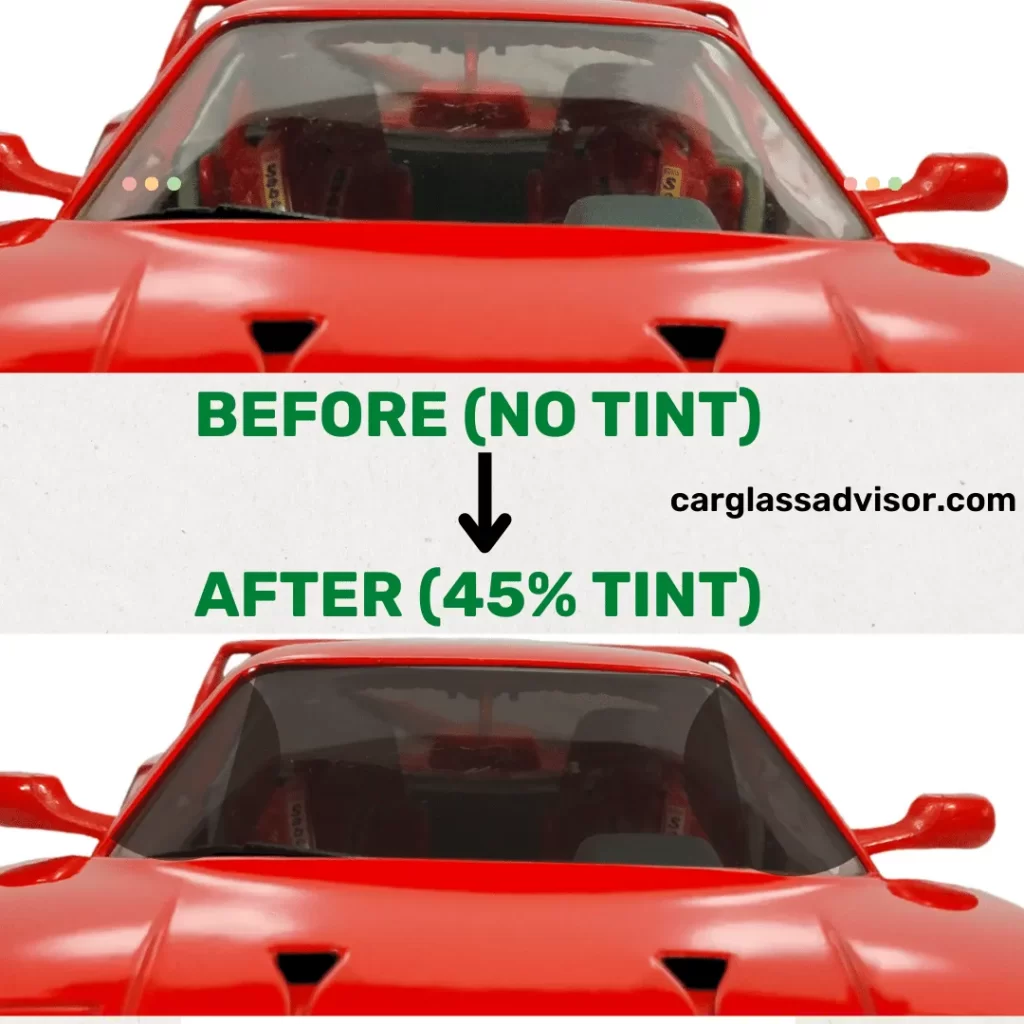Window tint is a popular aftermarket addition to vehicles that offers a variety of benefits, including increased privacy, protection from the sun’s harmful UV rays, and a more stylish appearance. For choosing the right window tint for your car, one important factor to consider is the tint percentage.
A 45% tint means that 45% of incoming light will pass through the window, while the remaining 55% will be blocked. This can provide a good balance between visibility and privacy, as well as protection from the sun’s rays. Many states, including Michigan, Connecticut, Utah, Louisiana, Hawaii, Idaho, Illinois, Kansas, Maine, Maryland, Massachusetts, Missouri, Nebraska, Nevada, New Hampshire, North Carolina, Oregon, South Dakota, Tennessee, West Virginia, Kentucky, Indiana, and Arkansas., allow for a 45% tint on the front, side and rear windows of a vehicle.
It’s important to note that window tint laws vary by state, so it’s always a good idea to check with your local regulations before applying any tint to your car. Some states may have stricter auto tint laws, or may only allow a certain percentage of tint on certain windows. For example, some states may allow a darker tint on the rear windows, but not on the front windows.
Overall, a 45% tint can provide a good level of privacy and protection from the sun’s rays, while still allowing a good amount of visibility. Just be sure to check with your local laws before applying any window tint to your vehicle.
What does 45% tint look like?
As you might expect, a 45% tint will be slightly darker than a 50% tint, but not as dark as a 35% or 20% tint. It is often a popular choice for those looking for a balance between visibility and privacy. A 45% tint will still allow a good amount of light to pass through, providing decent visibility while also blocking a significant amount of incoming light. This can be especially useful for reducing glare and heat, as well as providing a level of privacy.

Here is a visual comparison of different tint percentages:
- 5% tint: Very dark, almost completely blocks incoming light
- 20% tint: Dark, blocks a significant amount of incoming light
- 35% tint: Moderate darkness, blocks a moderate amount of incoming light
- 45% tint: Slightly darker, blocks a significant amount of incoming light
- 50% tint: Lightly tinted, blocks a moderate amount of incoming light
As you can see, a 45% tint falls in the middle of the spectrum, providing a good balance between visibility and privacy. It is important to consider the amount of tint that is right for you, based on your needs and preferences. Some people may prefer a darker tint for increased privacy, while others may want a lighter tint for better visibility. Ultimately, the choice will depend on your personal preferences and the specific circumstances of your vehicle.
Car Window Tint Percentage Visualization Tool
Select a percentage value from 1 to 100 to see how dark it is:
Selected Percentage:
Use the basic window tint visualization tool above to see how dark 45% tint is. Set the value to 45 and the tool will simulate the tint percentage for the most common black tinting film. However, for other tint colors, use our advanced tint percentage visualization tool. That said, the car picture below shows the comparison between no tint and 45% tint.

Can you see through 45% tint at night?
So, can you see through 45% tint at night? It's important to note that window tint can affect visibility at different times of day. During the day, a 45% tint will probably not have a significant impact on visibility. However, at night, when there is less ambient light, a 45% tint may slightly reduce visibility. While it is not as dark as a 20% or 35% tint, it will still block a very negligible amount of incoming light, which can make it slightly difficult to see through the window.
It's important to consider visibility when choosing window tint for your vehicle. If you frequently drive at night or in low light conditions, opt for a lighter tint percentage to ensure that you have good visibility. On the other hand, if you are primarily concerned with privacy and UV protection, a darker tint may be a good choice.
Ultimately, the right tint percentage will depend on your personal preferences and the specific needs of your vehicle. It's a good idea to consider the various factors that can affect visibility, such as the time of day and the lighting conditions, when deciding on window tint.
How much does 45% tint cost?
If you're considering adding window tint to your vehicle, you may wonder about the cost. The price of window tint can vary significantly depending on a variety of factors, including the size of the windows, the type of film used, and the location of the installation.
One important factor that can affect the cost of window tint is the size of the windows. Larger windows will typically require more material and labor to tint, leading to a higher overall cost. On the other hand, smaller windows will be less expensive to tint.
The type of film used can also affect the cost of window tint. There are several different types of film available, including dyed film, metallic film, and ceramic film. Dyed film is the most affordable option, while ceramic film is typically the most expensive. Each type of film has its own benefits and drawbacks, so it's a good idea to consider your priorities and budget when choosing the right film for your needs.
The location of the installation can also affect the cost of window tint. Some areas may have a higher demand for window tinting services, leading to higher prices. Additionally, the cost of labor can vary depending on the location.
So, how much does 45% tint cost? It's difficult to provide an exact price, as the cost can vary significantly depending on the specific circumstances. However, as a rough estimate, you can expect to pay anywhere from $100 to $400 for 45% tint on a standard passenger car. Keep in mind that this is just a general range, and the actual cost may be higher or lower depending on the size of the windows, the type of film used, and the location of the installation. It's a good idea to shop around and get quotes from multiple tinting companies to find the best price for your specific needs.
Is 45% tint worth it?
Ultimately, whether window tint is worth it will depend on your personal priorities and budget. If you value increased privacy and UV protection, and will pay for the benefits, then window tint may be an excellent investment for you. However, if you are primarily concerned with cost, consider other options, such as using window shades or using a windshield visor. It's important to carefully weigh the pros and cons of window tint and make a decision that is right for your specific needs and budget.
Conclusion
If you're considering adding window tint to your vehicle, it's important to know what the different percentages mean. A 45% tint means that 45% of light will pass through the window, while the remaining 55% will be blocked. In many states, including Michigan, Connecticut, Utah, Louisiana, Hawaii, Idaho, Illinois, Kansas, Maine, Maryland, Massachusetts, Missouri, Nebraska, Nevada, New Hampshire, North Carolina, Oregon, South Dakota, Tennessee, West Virginia, Kentucky, Indiana, and Arkansas, it is legal to use a 45% tint on the front, side and rear windows of your vehicle. However, it's always a good idea to check with your local laws before applying any window tint to your car to ensure compliance.

